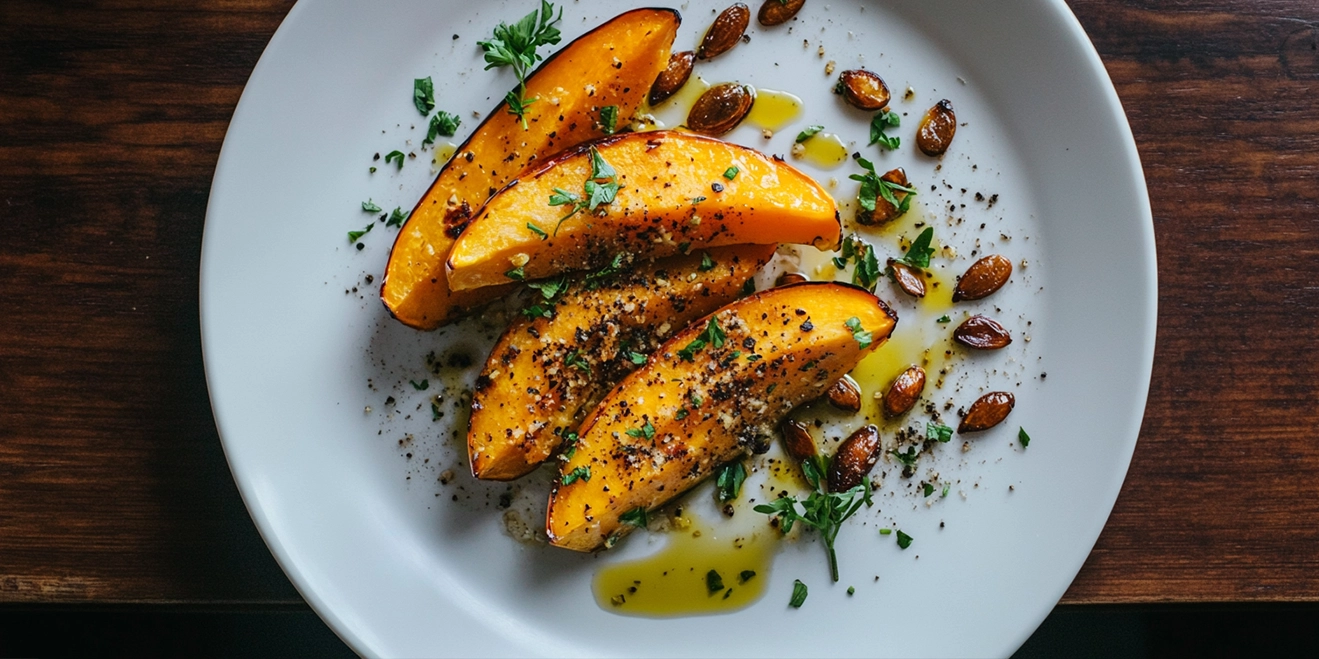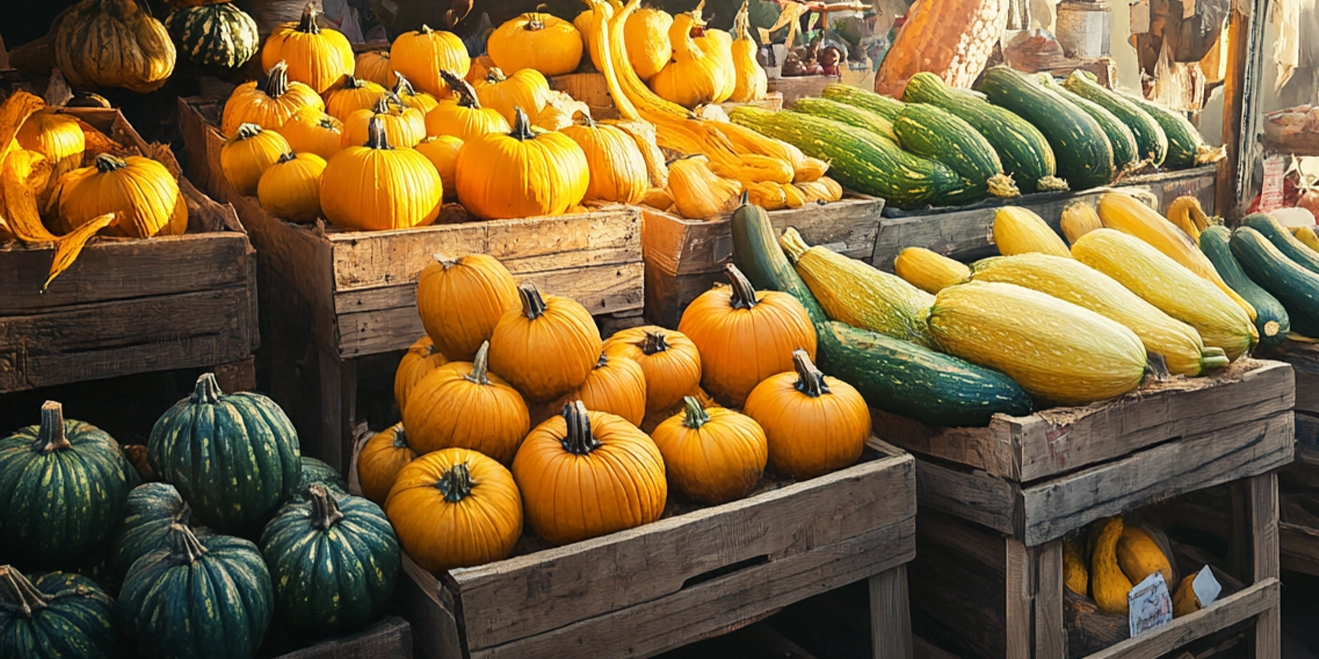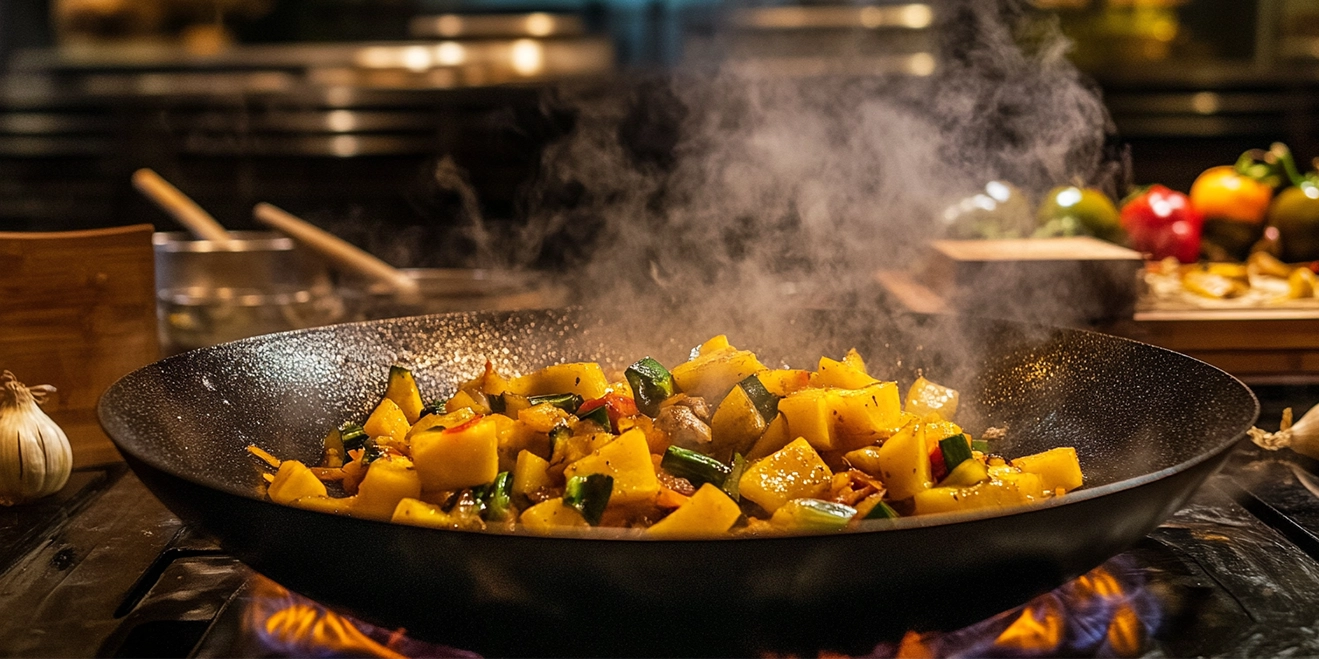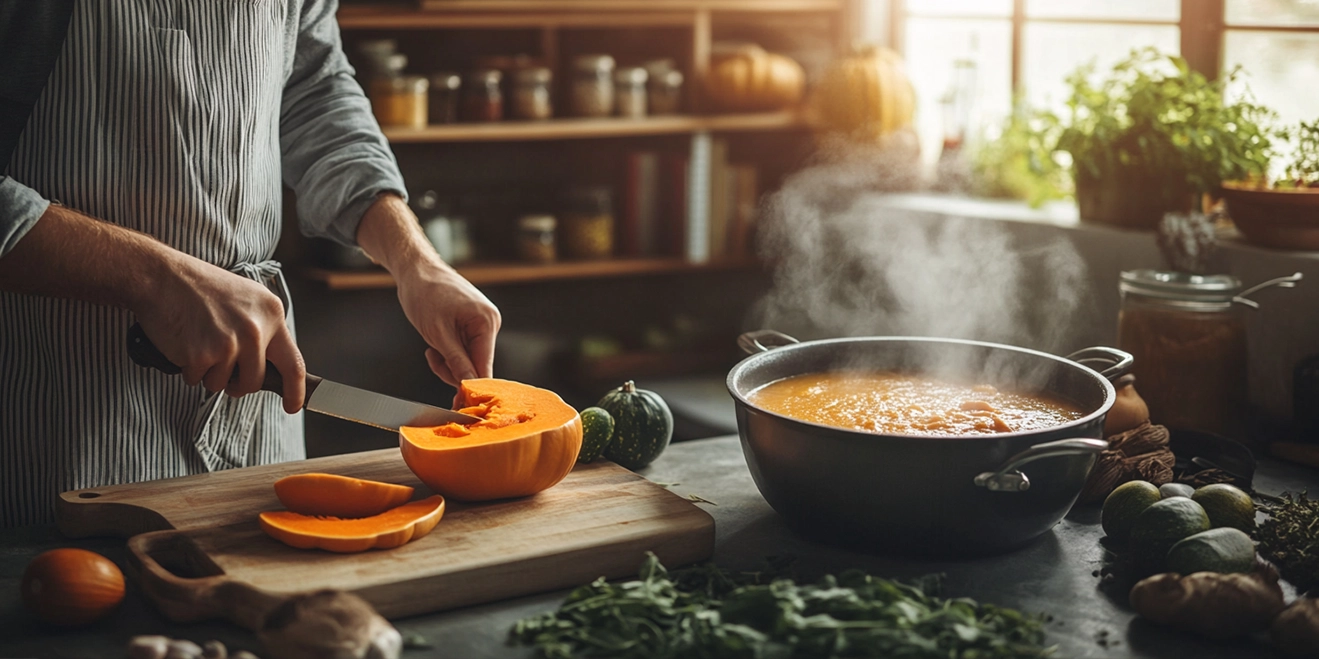
Table of Contents
What is the Cooking Methods for Squash? Overview of Squash Varieties and Cooking Methods
Squash is a versatile and nutritious vegetable of various types, each with a unique flavor, texture, and cooking methods for squash. Here’s a look at the different varieties of squash and the best ways to cook them.
Summer Squash
Summer squash varieties include zucchini, yellow squash, and pattypan squash. These tend to have tender skin and flesh, making them quick to cook.
Cooking Methods for squash:
- Sautéing: Slice or cube summer squash and sauté in olive oil or butter with garlic, salt, and pepper. This method works well for zucchini and yellow squash.
- Grilling: Cut the squash into thick slices or wedges and grill until tender, adding a bit of seasoning.
- Roasting: Toss them in olive oil, season with herbs and spices, and roast at 400°F (200°C) for 20–25 minutes.
Winter Squash
Winter squashes like butternut, acorn, spaghetti, and delicata squash have thicker skins and flesh, making them more suitable for longer cooking.
Cooking Methods:
- Roasting: Roasting is a popular method for winter squash. Cut them in half, remove seeds, and roast at 375°F (190°C) for about 40–50 minutes, depending on the size.
- Baking: You can also bake squash like acorn or butternut with a stuffing of grains, meats, or vegetables for a hearty meal.
- Boiling/Steaming: Winter squashes like butternut can also be peeled, cubed, boiled, or steamed in soups, purees, or casseroles.
Squash Soups and Stews
Squash is an excellent base for creamy soups and hearty stews. To make a squash soup, roast or boil it and blend it with onions, garlic, stock, and spices until smooth.
Squash Puree
Squash puree is an excellent addition to pies, casseroles, or smoothies. Roast or steam the squash until soft, then blend until smooth.
Grilled Squash
Grill slices of squash for a smoky flavor. Summer squash varieties like zucchini are excellent on the grill, while winter squash, such as delicata, can also be grilled after being cut into wedges.
Introduction to Squash: What is Squash? Understanding Different Types of Squash

Squash is a member of the gourd family, known for its wide range of shapes, sizes, and flavors. This versatile vegetable is native to the Americas and is cultivated in many parts of the world. It is often categorized into two main types: summer squash and winter squash, each with distinct characteristics and uses in the kitchen.
Summer Squash
Summer squash is characterized by its tender, edible skin, and mild flavor. It is harvested in the early stages of ripeness, which is why it has a softer texture and thinner skin compared to winter squash. Common varieties of summer squash include:
- Zucchini: One of the most popular summer squashes, zucchini has a mild, slightly sweet flavor and can be used in various dishes, from stir-fries to baked goods.
- Yellow Squash: Often yellow, this squash has a slightly firmer texture than zucchini and is often used in sautéed or roasted dishes.
- Pattypan Squash: This small, round squash has a unique shape and a delicate flavor, making it a great addition to salads or grilled dishes.
Winter Squash
Winter squash, on the other hand, is harvested when fully mature and has a thicker, tougher skin that can be difficult to peel. This squash is stored longer and is available throughout fall and winter. Some common varieties of winter squash include:
- Butternut Squash: With its smooth, orange flesh and sweet flavor, it is ideal for roasting, soups, and purees.
- Acorn Squash: Known for its deep green skin and mild, slightly sweet taste, it is often baked or stuffed with various fillings.
- Spaghetti Squash: This squash gets its name from the stringy texture of its flesh, which separates into strands when cooked. It is commonly used as a low-carb substitute for pasta.
- Delicata Squash: This small, cylindrical squash has a sweet flavor and tender skin, making it easy to cook and enjoy without peeling.
How Squash is Used in Cooking
Squash can be prepared in many ways, including roasting, grilling, boiling, steaming, and even raw in salads. It is used in various cuisines, from savory dishes like soups, casseroles, and stir-fries to sweet treats like pies and baked goods. The versatility of squash makes it a popular ingredient in both vegetarian and meat-based dishes.
Common Squash Varieties: Exploring Different Squash Types – Summer vs. Winter Squash
Squash is a diverse vegetable with many varieties, offering unique flavors and textures. The two main categories of squash are summer squash and winter squash, and understanding the differences between them is key to using them effectively in your cooking. Below, we explore the most common summer and winter squash types.
Summer Squash Varieties
Summer squash is typically harvested before it reaches full maturity, which means it has tender skins and a more delicate texture. These varieties are often used in lighter, fresher dishes and are best cooked quickly.
- Zucchini (Courgette)
- Description: Zucchini is one of the most popular types of summer squash. It has smooth, dark green skin and soft, mild-flavored flesh. It is incredibly versatile and used in various dishes, from savory stir-fries to baked goods.
- Cooking Tips: Zucchini can be sautéed, grilled, or roasted. It also works well in soups, casseroles, or even baked into bread.
- Yellow Squash
- Description: Yellow squash is similar to zucchini but has a bright yellow color and a slightly firmer texture. Its sweet flavor complements many types of seasonings and ingredients.
- Cooking Tips: Yellow squash is excellent for sautéing, roasting, or grilling. It can also be used in stir-fries or as a side dish.
- Pattypan Squash
- Description: Pattypan squash is a small, round squash with a scalloped edge. It comes in a variety of colors, including yellow and green. The flesh is soft, and the flavor is mild.
- Cooking Tips: Pattypan squash is often grilled, roasted, or stuffed. It’s also delicious when sliced thinly and used in salads.
Winter Squash Varieties
Winter squash is harvested when fully mature and has thick, tough skin that protects the flesh during storage. These squash types are typically heartier and have a sweeter, more robust flavor, making them ideal for fall and winter dishes.
- Butternut Squash
- Description: Butternut squash has smooth, pale tan skin and bright orange flesh. Its sweet and nutty flavor makes it perfect for roasting or using in soups and purees.
- Cooking Tips: Butternut squash is often roasted, pureed for soups, or used in risottos and casseroles. Its sweet flavor pairs well with spices like cinnamon, nutmeg, and ginger.
- Acorn Squash
- Description: Acorn squash is small, round, and green, with ribbed skin. The flesh is sweet, yellow-orange, and tender once cooked.
- Cooking Tips: Acorn squash is usually baked, often stuffed with grains, meat, or vegetables. It can also be roasted or mashed for a savory side dish.
- Spaghetti Squash
- Description: Spaghetti squash is unique for its stringy flesh, which resembles spaghetti noodles. It has a mild flavor and is often used as a low-carb alternative to pasta.
- Cooking Tips: Roast or microwave spaghetti squash, then use a fork to scrape out the “noodles.” Serve with marinara sauce, sautéed vegetables, or as a casserole base.
- Delicata Squash
- Description: Delicata squash is small, cylindrical, and has a creamy yellow and green striped skin. The flesh is sweet and tender, and its skin is edible, making it easier to prepare.
- Cooking Tips: Delicata squash can be roasted, baked, or sautéed. It is often sliced into rings and roasted with olive oil, salt, and pepper.
Key Differences Between Summer and Winter Squash
- Harvest Time: Summer squash is harvested early, while winter squash is left to ripen fully before harvesting.
- Texture: Summer squash has a tender, edible skin and soft flesh, whereas winter squash has thicker and denser flesh.
- Storage: Summer squash is perishable and should be used within a few days, while winter squash, due to its hard skin, can be stored for months.
- Cooking Time: Summer squash cooks quickly, whereas winter squash requires longer cooking times.
Preparing Squash for Cooking: How to Peel, Cut, and Seed Squash

Preparing squash for cooking can seem intimidating, especially with the tough skins of winter squash varieties. However, once you understand the basic steps for peeling, cutting, and seeding squash, you’ll easily handle these vegetables. Here’s a guide on cooking both summer and winter squash.
Preparing Summer Squash
Summer squash varieties, like zucchini, yellow squash, and pattypan squash, have tender skins and are usually much easier to prepare than winter squash.
Steps to Prepare:
- Washing: Rinse the squash under cold water to remove any dirt.
- Cutting: Summer squash can be sliced or cubed without peeling. Trim the ends off the squash.
- You can slice zucchini and yellow squash into rounds or half-moons for sautéing or roasting.
- Pattypan squash can be sliced into rings or wedges.
- Seeding (optional): Most summer squash varieties have tiny, edible seeds that don’t need to be removed. However, if the squash is large, you should scoop out some of the seeds for a cleaner texture.
Tip: For dishes like stir-fries or roasts, you can leave the skin on for added texture and nutrients, as it is edible and tender.
Preparing Winter Squash

Winter squashes, such as butternut, acorn, spaghetti, and delicata squash, have thicker, tougher skins that need to be peeled, and they contain seeds that must be removed.
Steps to Prepare:
- Washing: Start by rinsing the squash to remove dirt from the skin.
- Peeling: Use a sharp vegetable peeler or a chef’s knife to remove the tough skin of winter squash.
- Butternut squash: Peel the skin from top to bottom, then cut off the ends.
- Acorn squash: The skin can be challenging to peel, so it’s often easier to roast it whole first and then scoop out the flesh after it softens.
- Spaghetti squash: While you can peel spaghetti squash, it’s often cooked whole first, then sliced open and scraped into noodle-like strands.
- Delicata squash: The skin of delicata squash is thin and edible, so you don’t need to peel it. Slice it open and scoop out the seeds.
- Cutting: Use a sharp knife to carefully cut the squash in half. For larger squashes, cut them into quarters or smaller sections for easier handling.
- Seeding: Most winter squash varieties have seeds that need to be removed. Use a spoon to scoop out the seeds and stringy pulp from the center of each half. You can discard the seeds or save them for roasting.
- For Butternut squash, cut off the neck and peel it before halving it to remove the seeds.
- The seeds are quickly scooped out with a spoon once the squash is halved for Acorn squash.
Tip: You can save the seeds from winter squash varieties and roast them for a tasty snack. Just rinse, dry, and toss them with oil and seasoning before roasting.
Tips for Handling Squash
- Use a Sharp Knife: Winter squash, especially those with thick skins like butternut or acorn squash, can be challenging to cut. Use a sharp chef’s knife for safe, clean cuts.
- Microwave Method: If you’re struggling to cut a large winter squash, microwave it for a few minutes to soften the skin slightly. This can make it easier to cut in half.
- Safety: Always be cautious when handling large squash. Cutting them on a non-slip surface and using a stable cutting board will help prevent accidents.
Frequently Asked Questions (FAQs) about Squash
How do you prepare and eat squash?
Preparing squash typically involves peeling (if necessary), seeding, and cutting it into appropriate sizes for cooking.
- Summer Squash (e.g., zucchini, yellow squash): These varieties often have tender, edible skins. Wash them, trim off the ends, and cut them into slices, cubes, or wedges. You don’t need to peel or seed them for dishes like n’t-fries, salads, or sautés.
- Winter Squash (e.g., butternut, acorn, spaghetti squash): These squash have tough skins and seeds that need removal. Peel the squash using a vegetable peeler or a knife, cut it open, scoop out the seeds, and then cut it into chunks or slices. Some types, like delicata squash, have edible skins.
What is the Cooking methods for squash?
The preparation method for squash depends on the type of squash you are using. Here to prep squash for cooking:
- Wash: Rinse the squash under cold water to remove dirt.
- Peel (if needed): For winter squash like butternut or acorn, peel the skin with a vegetable peeler or knife.
- Cut: Slice or cube the squash according to your recipe. Cut it into halves or quarters for winter squash, then scoop out the seeds. For summer squash, slice or cube without the need to peel or seed (unless desired).
After prepping, you can cook squash in various ways, depending on the recipe, such as roasting, steaming, sautéing, or boiling.
How long does it take for squash to be cooked?
The cooking time for squash varies depending on the type, size, and method of cooking:
- Summer Squash (e.g., zucchini, yellow squash): These cook quickly, usually within 5–10 minutes, when sautéed, steamed, or boiled. Roasting takes about 20–25 minutes.
- Winter Squash (e.g., butternut, acorn, spaghetti squash): These take longer to cook. Roasting typically takes 30–50 minutes, depending on the size. Boiling or steaming can take 15–20 minutes for cubed pieces. Spaghetti squash can take 30–45 minutes to roast.
How do you cut and cook squash?
To cut and cook squash, follow these steps:
- Wash the Squash: Rinse it under cold water to clean it.
- Cut:
- For summer squash, slice or cube it into rounds or half-moons.
- For winter squash, peel it (if necessary), cut it in half, and scoop out the seeds. Then, cut it into chunks or wedges for cooking.
- Cook:
- Sautéing: Heat a pan, add oil or butter, and cook squash for 5–10 minutes, stirring occasionally.
- Roasting: Preheat the oven to 375–400°F (190–200°C), toss the squash with olive oil and seasoning, and roast for 20–50 minutes.
- Boiling: Bring a pot of water to a boil, add the squash, and cook for 5–15 minutes, depending on the type.
- Steaming: Steam squash for about 10–15 minutes until tender.
- Grilling: Slice squash into thick rounds or wedges, brush with oil, and grill for 4–6 minutes per side.
